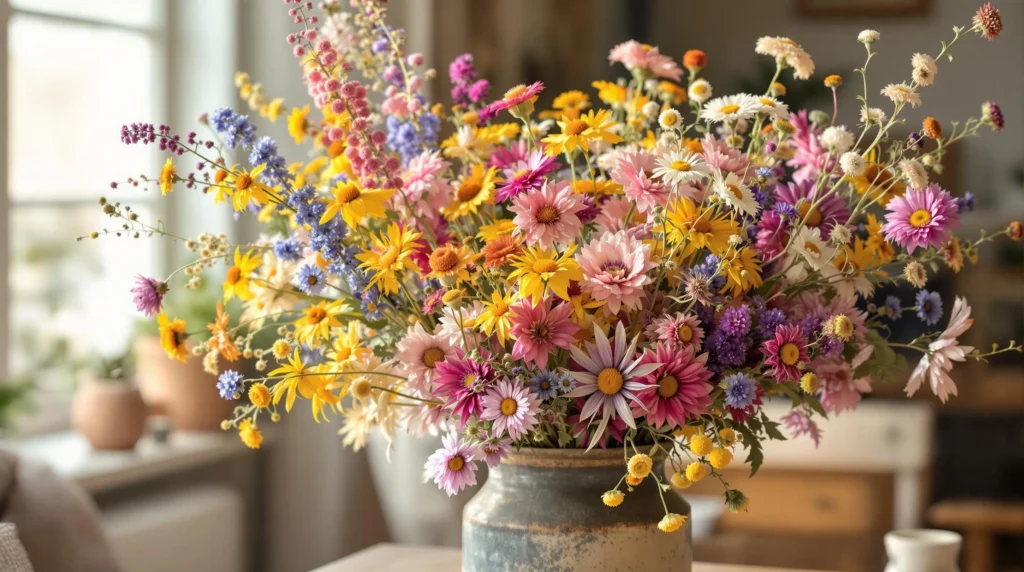10 Uncommon But Beautiful Flowers For Drying Arrangements
- Nigella (Love-in-a-Mist) – These delicate star-shaped blooms transform into decorative seed pods when dried, creating unique sculptural elements in arrangements. The pods maintain their intricate structure and dusty blue-gray color, making them perfect focal points in rustic bouquets.
- Strawflower (Xerochrysum bracteatum) – Strawflowers feel papery even when fresh, making them exceptional candidates for drying. Their vibrant colors—ranging from bright oranges to deep purples—hold remarkably well during the drying process, maintaining their daisy-like appearance for years.
- Gomphrena (Globe Amaranth) – These clover-like blooms retain their round shape and vivid purple, pink, or white hues perfectly when dried. Their sturdy stems and long-lasting color make them ideal for both vertical elements and clustered accents in dried arrangements.
- Celosia (Cockscomb) – With its brain-like texture and velvety appearance, dried celosia adds dramatic flair to arrangements. Available in fiery reds, oranges, and yellows, these architectural blooms maintain their unique form and rich coloration after drying.
- Sea Holly (Eryngium) – These thistle-like flowers dry into stunning silvery-blue spiky blooms that add texture and visual interest. Their metallic appearance creates dramatic contrast in dried arrangements while providing structural stability to more delicate components.
- Chinese Lantern (Physalis alkekengi) – The papery orange husks of Chinese lanterns become even more vibrant when dried. Their distinctive lantern shape adds whimsical dimension to fall arrangements and maintains structural integrity for years when properly preserved.
- Lunaria (Honesty/Money Plant) – Often called “silver dollars,” lunaria’s translucent seed pods develop a pearlescent quality when dried. These circular discs catch light beautifully and add an ethereal, delicate quality to arrangements while providing wonderful structural elements.
- Craspedia (Billy Buttons) – These perfectly round yellow balls on straight stems dry exceptionally well, maintaining both their distinctive shape and sunny color. Their architectural quality adds playful geometry to dried compositions while providing long-lasting visual interest.
- Amaranthus (Love-Lies-Bleeding) – The dramatic cascading tassels of amaranthus maintain their flowing form when dried. Available in rich burgundies, greens, and golds, these dramatic drooping blooms add movement and elegant lines to arrangements.
- Scabiosa Pods (Pincushion Flower) – After the petals fall, scabiosa forms textural seed heads that resemble intricate, alien-like structures. These light brown pods maintain their detailed honeycomb pattern when dried, adding sophisticated visual interest and delicate texture to arrangements.
Discovering Lunaria: The Enchanting Money Plant
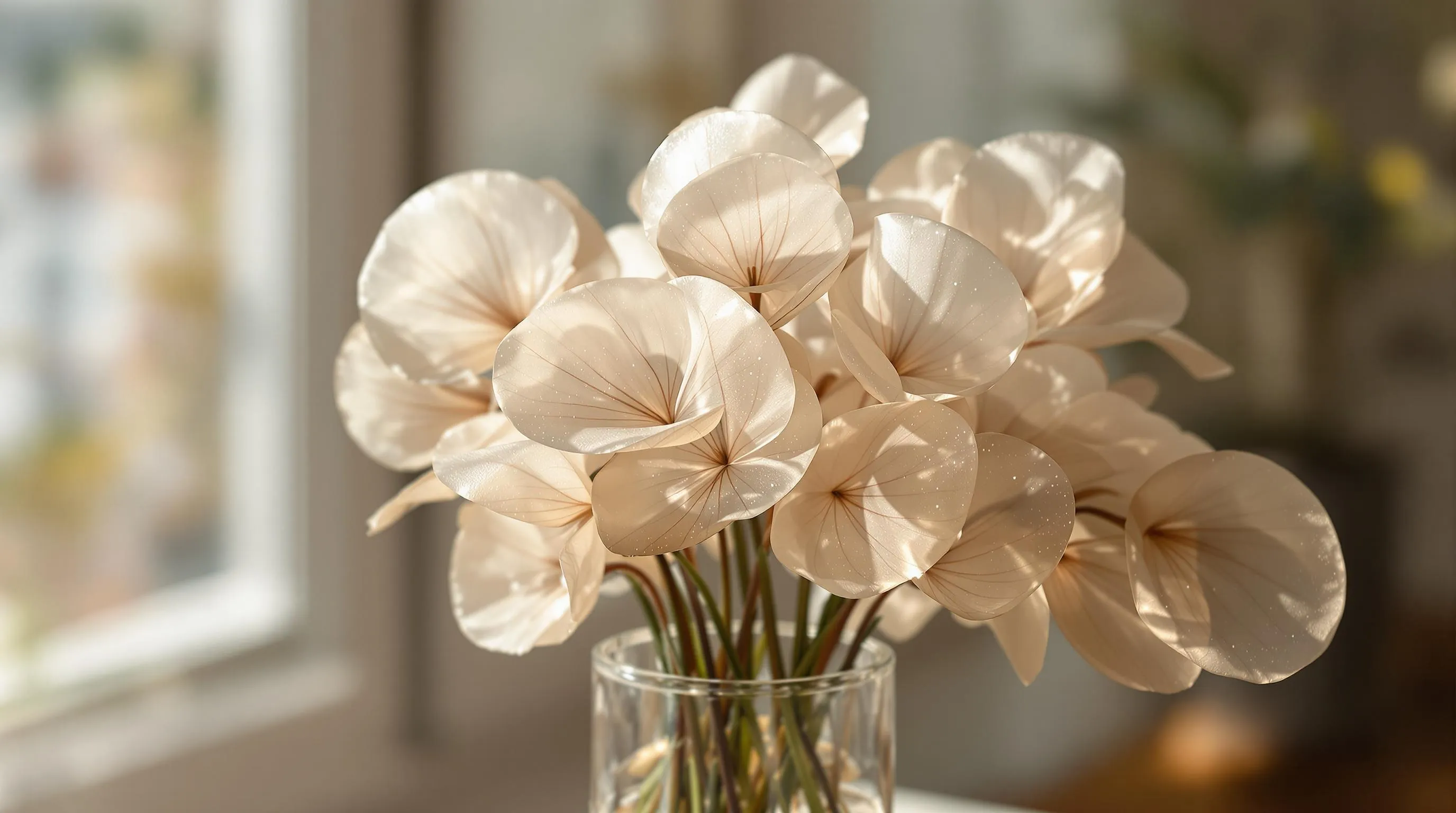
Lunaria, commonly known as the Money Plant or Honesty, captivates with its translucent, silver-dollar shaped seed pods that shimmer when light passes through them. This biennial plant begins with purple or white flowers in spring, but it’s the papery seed pods that emerge afterward that make Lunaria a prized addition to dried arrangements.
How To Properly Harvest And Dry Lunaria
For the most stunning dried Lunaria, timing your harvest is crucial. Wait until the seed pods have matured and turned from green to a silvery-brown color, typically in late summer or early fall. Cut the stems on a dry day when there’s no moisture present, selecting stalks with intact pod clusters. Remove any damaged pods and strip off the leaves, which don’t dry well. Hang the stems upside down in small bunches in a dark, dry, well-ventilated area away from direct sunlight. After 2-3 weeks, gently rub the outer husks of the pods between your fingers to reveal the translucent inner discs. For preservation, you can spray the dried pods with clear acrylic sealer to maintain their delicate appearance for years.
Creative Ways To Display Dried Lunaria
Dried Lunaria’s ethereal quality makes it versatile for many display options. Create a minimalist arrangement by placing several stems in a tall, slender vase for an elegant focal point. Weave Lunaria into wreaths or garlands where light can pass through the translucent discs, creating a magical effect when hung near windows. For tabletop displays, lay stems flat in a shallow dish or incorporate them into centerpieces with other dried elements like wheat or grasses. Try mounting individual seed pods on wire to include in boutonnieres or small gift toppers. For a modern look, frame pressed Lunaria branches between glass for botanical wall art that catches light beautifully. You can also dye the pods with fabric dye for colorful variations that maintain their translucent quality.
Embracing Globe Amaranth: Nature’s Everlasting Button

Globe Amaranth (Gomphrena globosa) stands out in dried arrangements with its perfectly round, button-like blooms that maintain their shape and vibrant colors long after harvesting. These cheerful, clover-like flowers bring a playful yet sophisticated touch to any dried display, earning them the nickname “everlasting” for their remarkable durability.
Best Harvesting Time For Globe Amaranth
Harvest Globe Amaranth when the flowers are fully open but still fresh—typically in late summer to early fall when blooms are at their peak vibrancy. Morning harvesting yields the best results, after the dew has dried but before the heat of the day sets in. Look for flowers with firm, crisp petals and avoid any showing signs of browning or wilting. Cut stems at least 6-8 inches long to provide flexibility for arrangement designs and include some foliage for a natural look. For the longest-lasting dried specimens, select blooms that have just reached maturity rather than older flowers that have begun to fade.
Color Preservation Techniques For Globe Amaranth
Preserving Globe Amaranth’s stunning colors requires proper drying techniques that protect their natural vibrancy. Hang bundles of 5-7 stems upside down in a dark, dry area with good air circulation to prevent color fading from sunlight exposure. For optimal color retention, dry flowers quickly at temperatures between 70-80°F with humidity below 60%. Silica gel drying produces the most vivid results—simply bury the flower heads in silica gel for 3-5 days in an airtight container. Spray dried blooms with UV-resistant floral preservative to maintain their magenta, purple, white, or orange hues for months or even years. Avoid direct sunlight exposure after drying to prevent the rich colors from bleaching out prematurely.
Incorporating Strawflowers: The Paper-Like Perennials
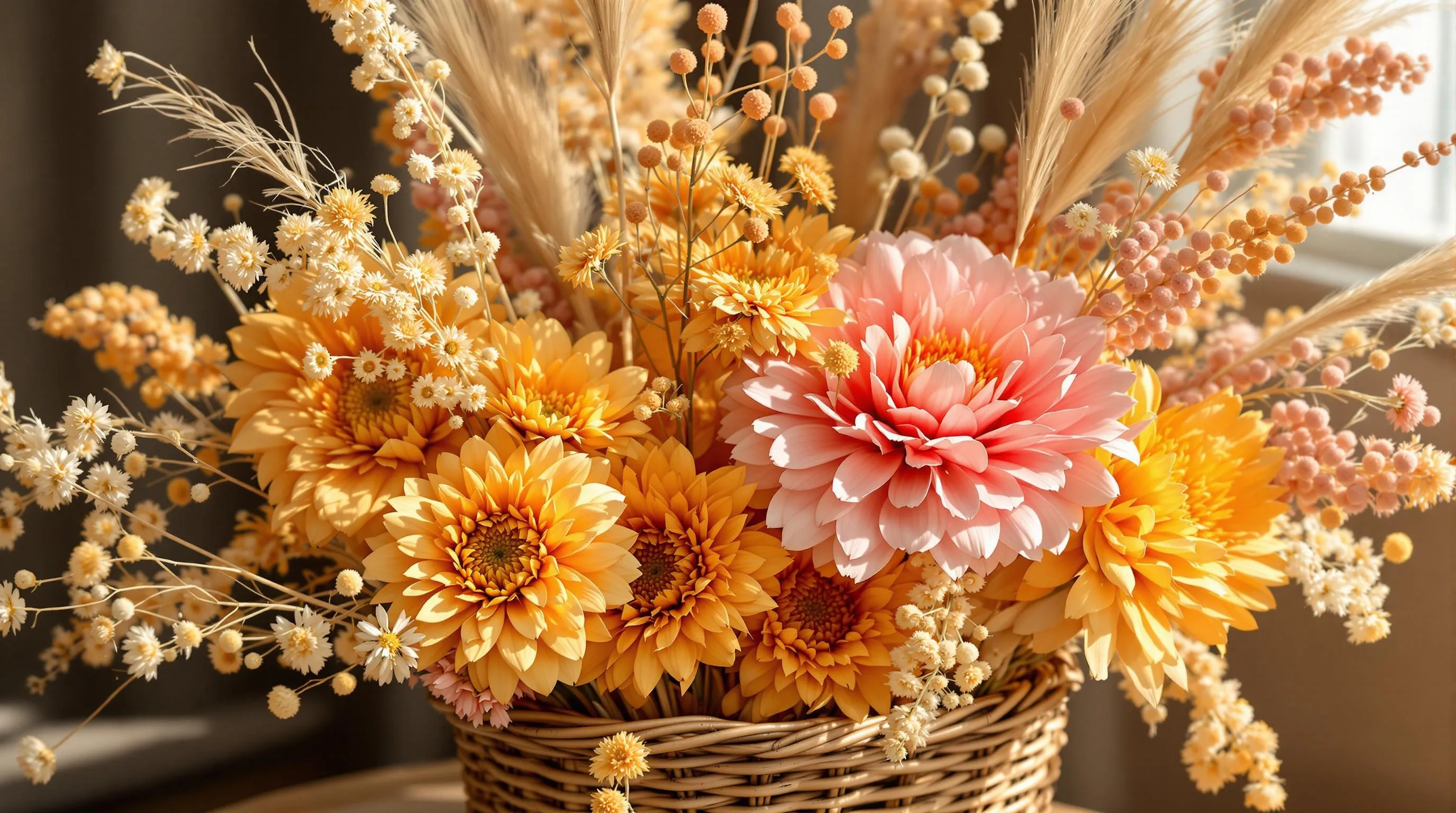
Strawflowers (Xerochrysum bracteatum) are remarkable dried flower specimens with stiff, papery petals that maintain their shape and vibrant colors long after harvesting. These Australian natives come in a stunning array of hues including gold, orange, pink, red, and white, making them perfect centerpieces for dried arrangements. Their crisp texture and long-lasting nature have earned them the nickname “everlasting flowers” among floral enthusiasts.
Drying Methods That Maintain Strawflower Vibrancy
Harvest strawflowers when they’re about three-quarters open for optimal drying results. Cut stems in the morning after dew has evaporated but before the day’s heat intensifies to preserve maximum color. Strip excess foliage from stems and gather them in small bunches secured with rubber bands or twine. Hang these bunches upside down in a dark, dry area with good air circulation for 2-3 weeks. For superior color preservation, try drying strawflowers in silica gel—simply bury the flower heads in the medium for 3-5 days in an airtight container. This method locks in the most brilliant colors and creates perfectly preserved blooms that look almost fresh-cut. Avoid direct sunlight during the drying process as UV rays can fade their distinctive vibrant hues.
Combining Strawflowers With Other Dried Elements
Strawflowers create stunning focal points when paired with complementary dried materials. Combine them with delicate Lunaria seed pods for a textural contrast that highlights the strawflower’s structured form. For dramatic arrangements, mix strawflowers with the cascading tassels of Amaranthus to create visual movement. Pair golden strawflowers with blue Sea Holly or Echinops for a striking color combination that draws the eye. For rustic arrangements, integrate strawflowers with dried grasses like bunny tails or pampas grass to add height and softness. Their sturdy nature also makes them excellent companions for seed pods and botanical elements with interesting shapes. When designing, position strawflowers at varying heights throughout your arrangement to create dimension and visual interest that showcases their unique paper-like texture.
Exploring Chinese Lanterns: Fiery Orange Beauties
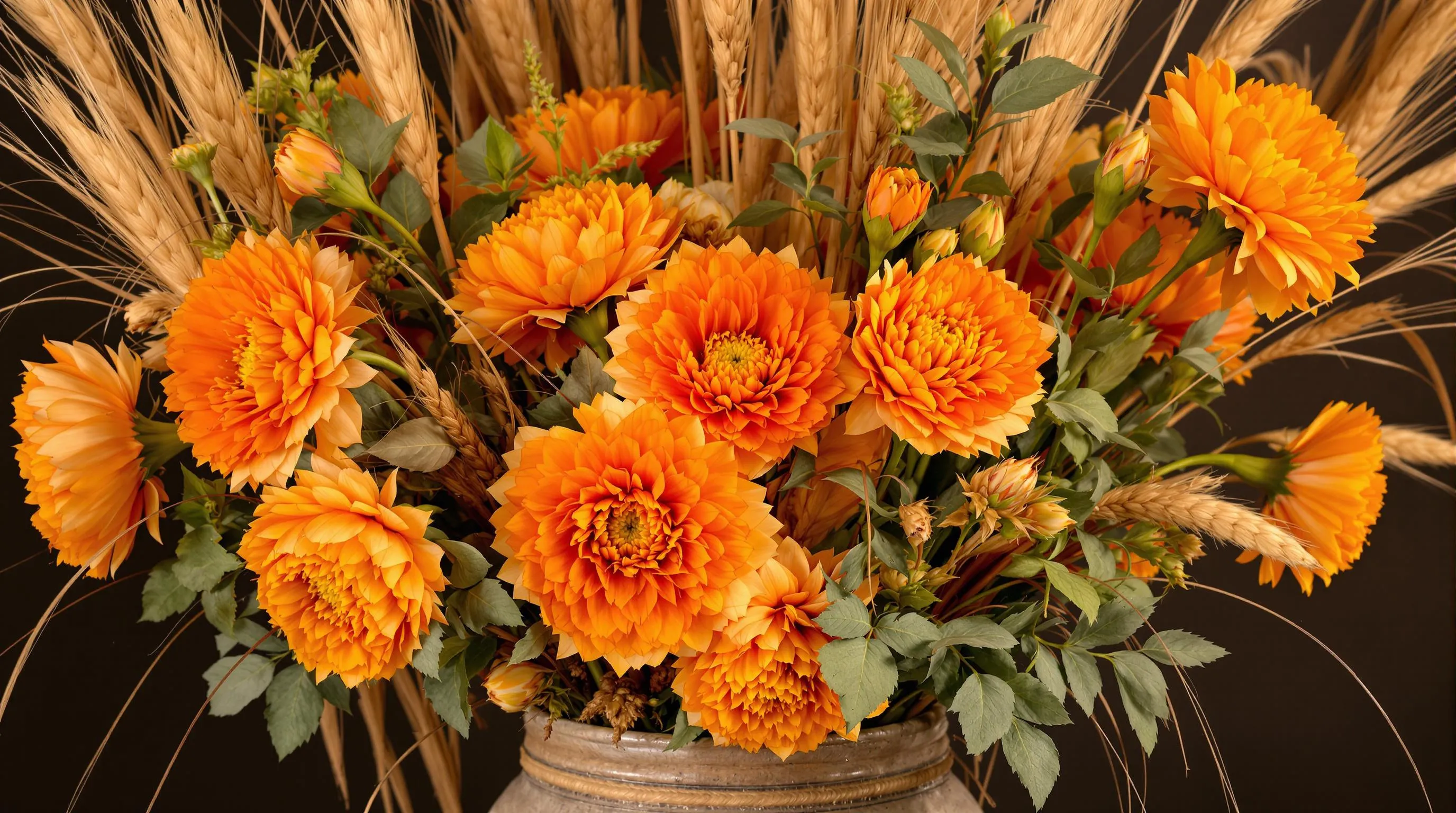
Chinese Lanterns (Physalis alkekengi) stand out in dried arrangements with their vibrant orange husks that resemble miniature paper lanterns. These eye-catching plants transform dramatically as they mature, developing from inconspicuous white flowers into striking papery pods that house small fruits. Their fiery color and distinctive shape make them an exceptional choice for adding warmth and whimsy to dried floral displays.
From Garden To Vase: Chinese Lantern Preparation
Harvesting Chinese Lanterns at the right moment is crucial for creating stunning dried arrangements. Wait until late summer or early fall when the lanterns have turned bright orange and the calyxes have fully developed their papery texture. Cut stems with sharp scissors, selecting branches with multiple lanterns for the most dramatic effect. Remove any damaged husks before drying. For best results, hang the stems upside down in bundles of 5-7 stems in a dark, dry location with good air circulation. The drying process typically takes 2-3 weeks. Once dried, handle the delicate husks carefully to prevent crushing. For long-term preservation, spray the dried lanterns with a UV-resistant clear floral spray to help maintain their vibrant orange color.
Seasonal Arrangements Featuring Chinese Lanterns
Chinese Lanterns shine in autumn-themed arrangements, where their bold orange color complements other fall elements. Combine them with dried wheat stalks, ornamental grasses, and deep burgundy amaranthus for a harvest-inspired display. For winter arrangements, pair Chinese Lanterns with evergreen branches, pinecones, and silver lunaria pods for a festive holiday look. Create stunning table centerpieces by placing shorter stems of Chinese Lanterns in low vessels with dried hydrangeas and seed pods. You can also incorporate them into wreaths by attaching individual lanterns with floral wire to a grapevine base. For year-round interest, display a few statement stems in a tall clear glass vase, allowing their unique silhouettes to create visual impact against a neutral wall. Their warm orange glow works surprisingly well with dried blue thistle and white strawflowers for a striking color contrast that enlivens any space.
Showcasing Sea Lavender: Delicate Cloud-Like Blooms
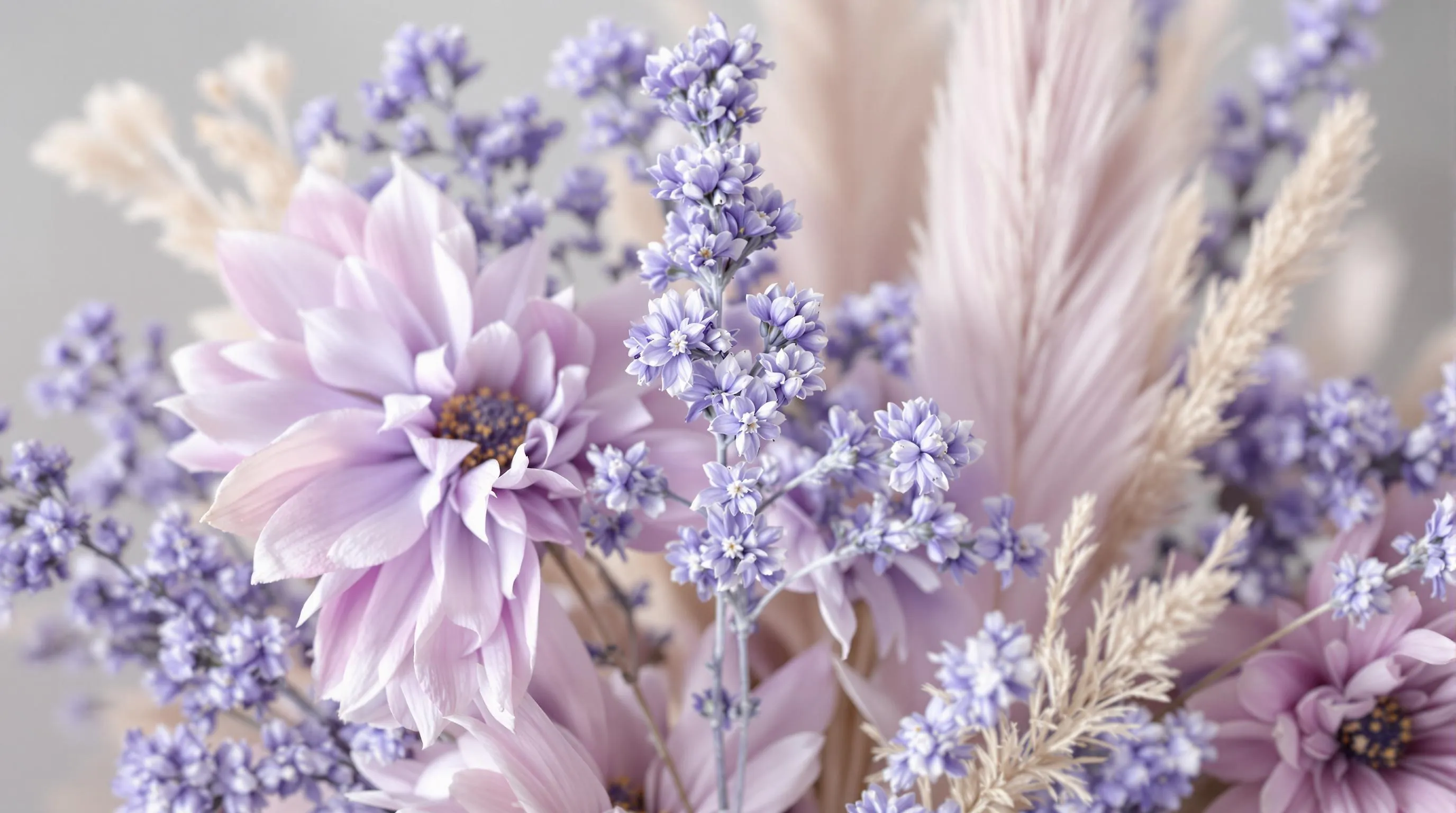
Sea Lavender (Limonium) creates an ethereal effect in dried arrangements with its delicate, misty appearance. Unlike its name suggests, this flower isn’t related to true lavender but offers similar versatility with its cloud-like sprays of tiny blooms. You’ll find sea lavender adds a light, airy texture that beautifully contrasts with more structured dried flowers.
Why Sea Lavender Maintains Its Color When Dried
Sea Lavender’s exceptional color retention comes from its naturally papery texture and low moisture content. The tiny flowers contain minimal water to begin with, allowing them to dry with their purple, blue, or white hues largely intact. This natural preservation quality stems from the plant’s coastal origins, where it evolved to withstand harsh, salty environments. For best results, harvest Sea Lavender when flowers are fully open but still fresh, typically in mid to late summer. Hang small bunches upside down in a dark, dry space with good air circulation. The drying process usually takes 2-3 weeks, requiring minimal intervention compared to other flowers that need special drying agents to maintain their appearance.
Pairing Sea Lavender With Complementary Dried Flowers
Sea Lavender creates stunning combinations when paired with contrasting textures and forms. Match it with structural elements like Craspedia (Billy Buttons) for color contrast or Eryngium (Sea Holly) for textural interest. The delicate sprays work beautifully with dramatic Amaranthus tassels, creating a ever-changing visual balance. For a sophisticated neutral arrangement, combine Sea Lavender with dried Lunaria seed pods and bleached Strawflowers. The airy quality of Sea Lavender also makes it perfect for filling negative space between larger blooms like dried Celosia or Globe Amaranth. Consider incorporating grasses like Bunny Tails or Pampas for a contemporary, textural arrangement that highlights Sea Lavender’s delicate nature while adding movement and dimension.
Adding Yarrow: The Versatile Wildflower
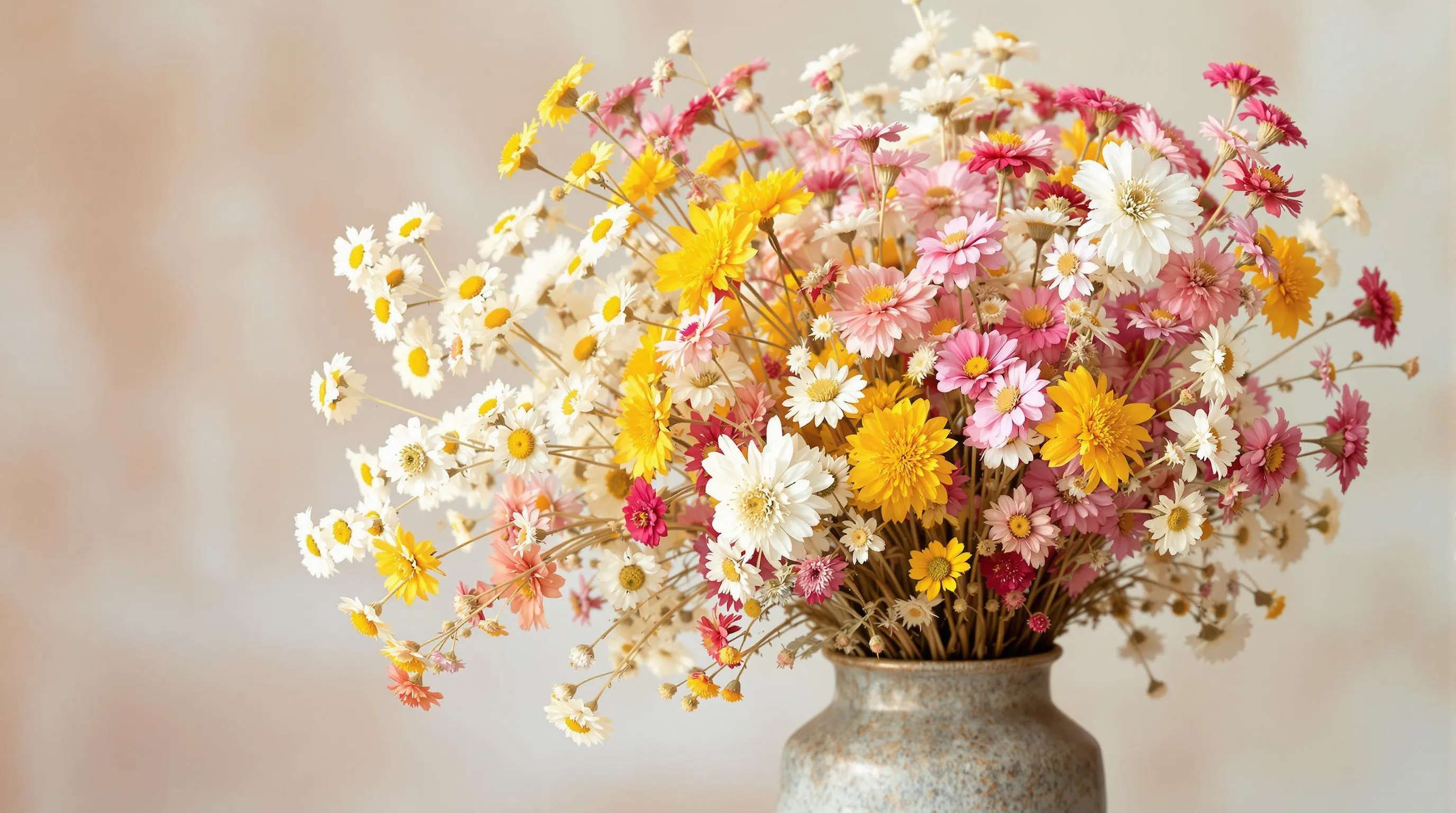
Yarrow (Achillea millefolium) stands out as one of the most adaptable wildflowers for dried arrangements, offering feathery foliage and flat-topped flower clusters in shades ranging from classic white to vibrant yellows, pinks, and reds. This hardy perennial not only adds delicate texture and architectural interest to dried displays but also brings medicinal history and folklore to your botanical creations.
Multiple Drying Techniques For Yarrow
Yarrow’s versatility extends to how you can preserve it, with several effective methods yielding different aesthetic results. Air-drying works exceptionally well—simply gather stems when flowers are fully open but before they begin to fade, remove excess foliage, and hang small bundles upside down in a dark, dry area for 2-3 weeks. For faster results, press yarrow between absorbent papers in a flower press, creating flat specimens perfect for framed art or greeting cards. Silica gel drying maintains yarrow’s three-dimensional structure and vibrant colors—completely cover the flower heads in silica gel and allow them to dry for 3-5 days. Each technique preserves yarrow’s distinctive umbrella-shaped blooms while highlighting different aspects of its natural beauty.
Yarrow As A Filler In Dried Arrangements
Yarrow excels as a structural filler that elevates entire dried compositions. Its lacy, disc-shaped flower heads create natural transitions between focal flowers while adding airy volume without overwhelming other elements. Position yarrow stems at varying heights throughout arrangements to create depth and movement, or use them to frame dramatic blooms like dried peonies or dahlias. The neutral tones of white yarrow complement virtually any color palette, while colored varieties can introduce subtle hues that tie arrangements together. Yarrow’s strong stems maintain their position without drooping, making them ideal for establishing the framework of wreaths, garlands, and bouquets. For maximum impact, combine yarrow with contrasting forms like the round globes of craspedia or the spiky texture of eryngium to create visually ever-changing dried displays that maintain interest throughout the seasons.
Featuring Celosia: The Flame-Like Statement Flower
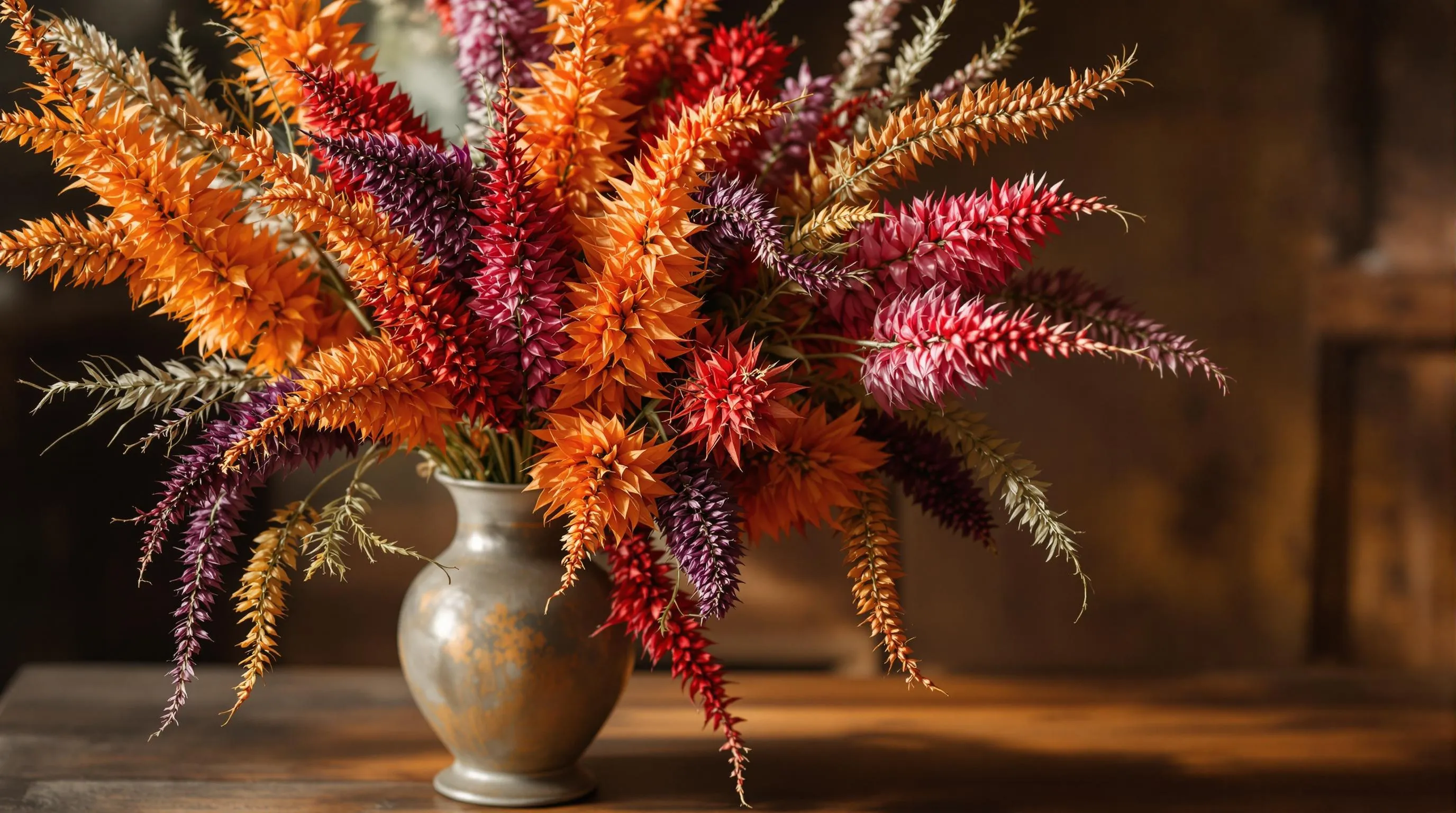
Celosia, with its bold flame-like or brain-like formations, stands out as one of the most dramatic flowers for dried arrangements. This architectural bloom comes in vibrant reds, oranges, yellows, and purples, maintaining its striking appearance long after drying. Whether you choose the plume variety (resembling flames) or the cockscomb type (with its brain-like folds), Celosia adds unmistakable visual interest to any dried display.
Preserving Celosia’s Unique Texture And Color
To preserve Celosia’s remarkable texture and vivid colors, harvest the stems when they’re fully developed but before they start dropping pollen. Cut stems in the morning after dew has dried but before the heat of day sets in. Remove leaves from the lower portions of the stems and bundle 5-8 stems together with a rubber band. Hang these bundles upside down in a dark, dry area with good air circulation, ensuring the stems don’t touch each other. For best color retention, keep them away from direct sunlight during the drying process, which typically takes 2-3 weeks. If you’re seeking perfect preservation of color, consider using silica gel—simply bury the flower heads in the gel for 3-5 days in an airtight container. This method maintains nearly 90% of Celosia’s original vibrant hues.
Statement Arrangements With Dried Celosia
Dried Celosia serves as an impressive focal point in arrangements due to its substantial size and unusual form. Create dramatic vertical displays by placing tall Celosia plumes in slender vases, allowing them to tower over complementary flowers. For stunning contemporary arrangements, pair burgundy Celosia with silver Lunaria and cascading Amaranthus for a rich color palette with varied textures. The cockscomb variety works beautifully in wreaths or centerpieces, where its intricate texture can be appreciated up close. For a modern minimalist statement, arrange several stems of the same color Celosia in a simple ceramic vessel—the architectural quality of these blooms means they need little accompaniment to create impact. Their substantial presence makes them perfect for large-scale dried installations or as standout elements in wedding bouquets and event decorations.
Including Gomphrena: The Resilient Globe Flower
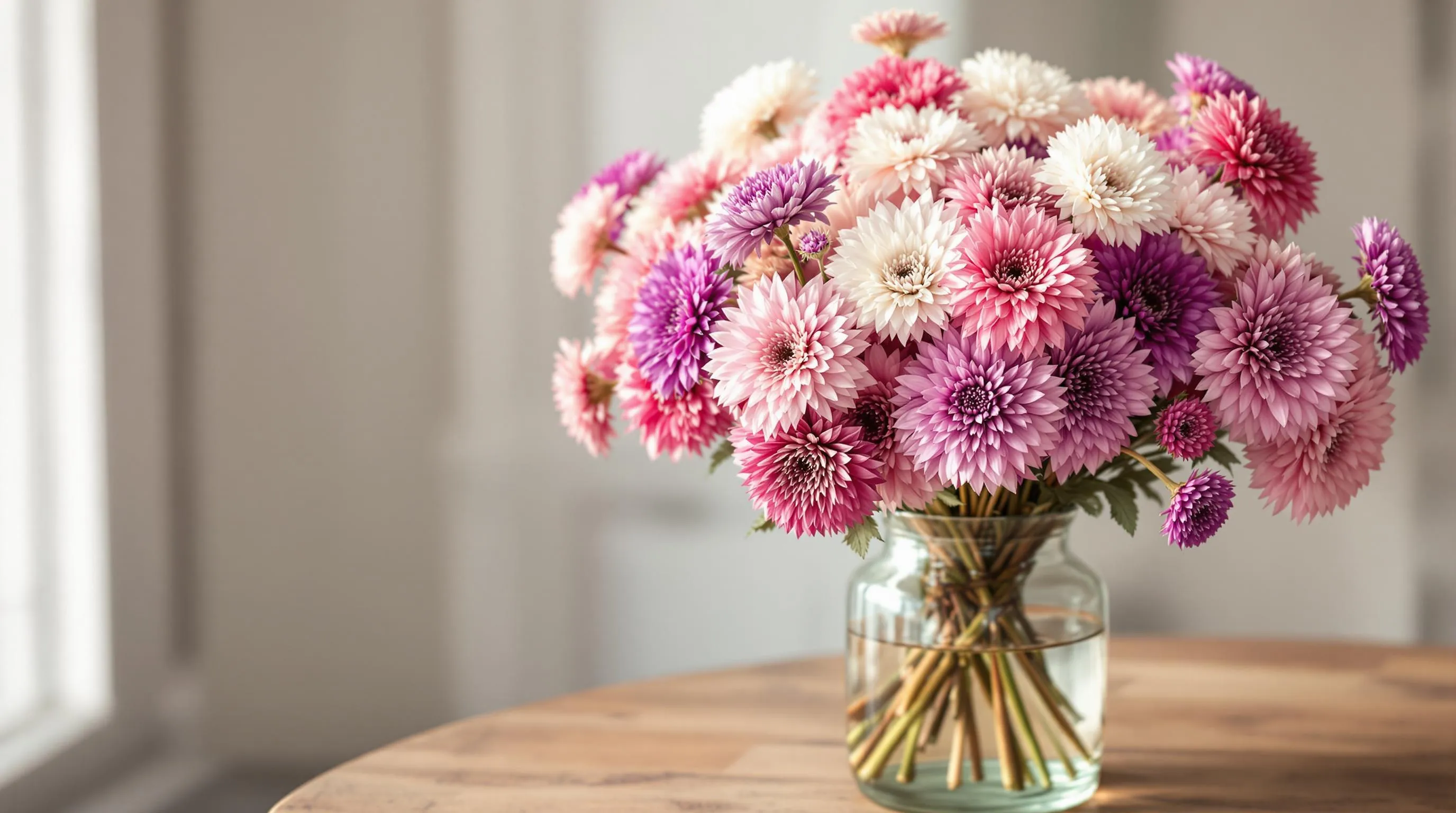
Gomphrena, commonly known as Globe Amaranth, stands out among dried flowers for its exceptional resilience and color retention. These perfect little spherical blooms maintain their shape and vibrant hues long after cutting, making them invaluable additions to any dried arrangement.
Air-Drying Versus Silica Gel For Gomphrena
When preserving Gomphrena, you have two excellent methods to choose from, each offering distinct advantages. Air-drying provides the most accessible approach—simply gather stems in small bunches, secure with twine, and hang them upside down in a dark, warm, well-ventilated space for 2-3 weeks. This traditional method works remarkably well with Gomphrena because of its naturally low moisture content. For superior color preservation, silica gel drying delivers exceptional results. Place your Gomphrena blooms in an airtight container, completely cover them with silica gel, and seal for 3-5 days. This method locks in the vivid pinks, purples, whites, and oranges that make Gomphrena so desirable. While air-drying is cost-effective and simple, silica gel offers unmatched color vibrancy—especially for those precious deep magenta and purple varieties that can otherwise fade slightly.
Year-Round Decorating With Dried Gomphrena
Dried Gomphrena offers remarkable versatility for year-round decorating projects. Create stunning seasonal wreaths by combining these colorful globes with other dried elements—pair purple Gomphrena with wheat stalks for fall displays or mix white varieties with evergreen sprigs for winter arrangements. Their perfect circular form makes them ideal for adding balanced structure to asymmetrical bouquets, while their bold colors create natural focal points in neutral-toned arrangements. For modern displays, group different colored Gomphrena in clear glass containers for minimalist appeal, or scatter them among fairy lights in hurricane vases for enchanting illuminated centerpieces. Their durability allows them to withstand handling for crafting projects like garlands, gift toppers, and botanical jewelry. Unlike many dried flowers, Gomphrena maintains its structural integrity without shattering, allowing you to enjoy these resilient blooms in your decorative projects for years when stored properly.
Utilizing Echinops: The Striking Globe Thistle
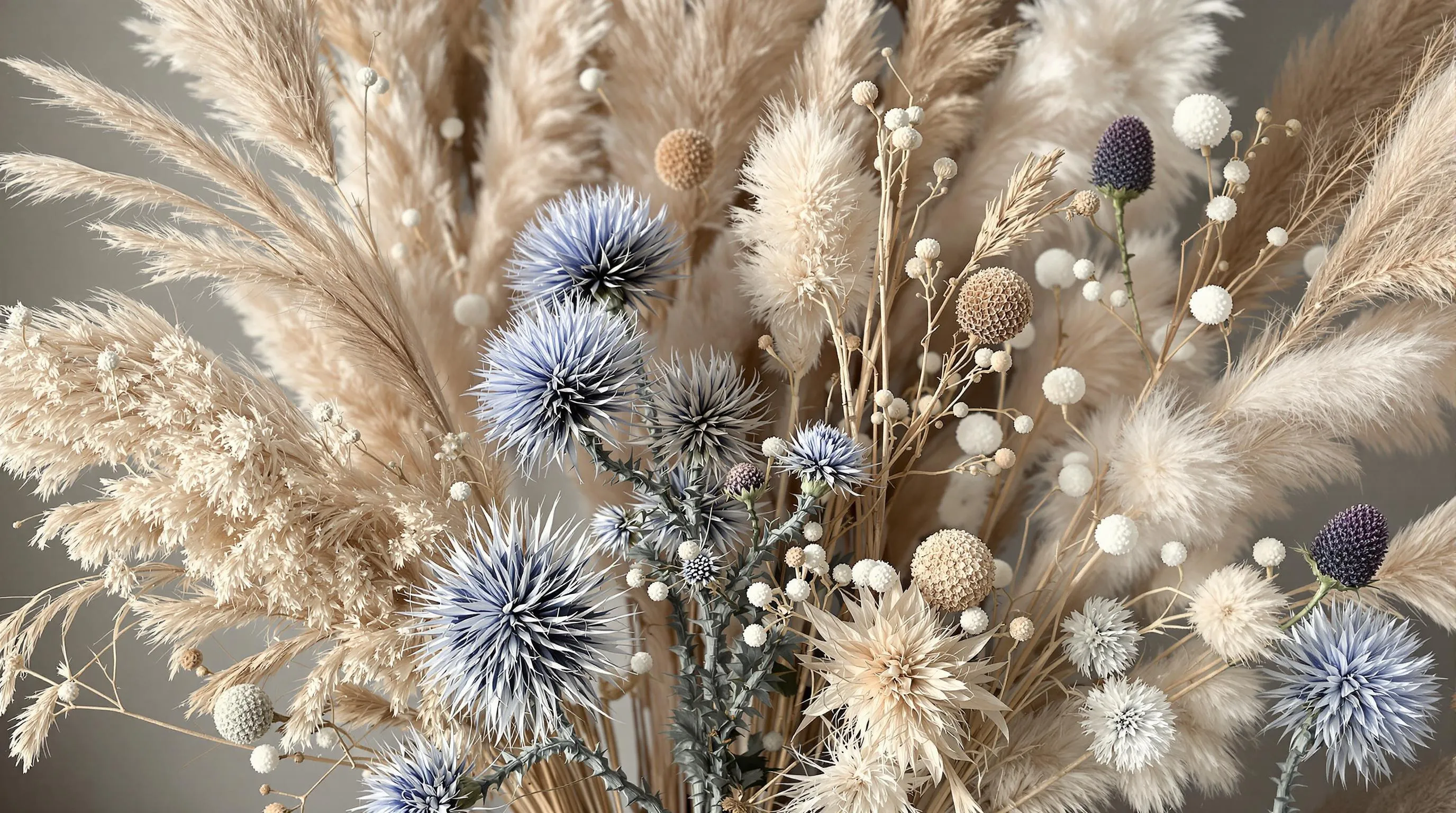
Echinops, commonly known as Globe Thistle, adds architectural interest to dried arrangements with its perfectly spherical, steel-blue flower heads. These distinctive blooms maintain their structural integrity and unique color when dried, making them an exceptional choice for long-lasting floral displays.
Harvesting And Drying Echinops For Longevity
Harvest Echinops when the globes are fully formed but before they start to fade or develop a dusty appearance. The ideal time is typically mid to late summer when the blue color is at its peak intensity. Cut stems in the morning after dew has dried but before the day gets too hot, selecting stems with fully developed flower heads. For best results, strip lower leaves from the stems and gather them in small bunches secured with rubber bands or twine. Hang these bunches upside down in a dark, dry area with good air circulation for 2-3 weeks. Alternatively, you can use silica gel to preserve the vibrant blue-gray color more effectively—simply place the flower heads in a container of silica gel for 3-5 days. Once completely dry, the stems become stiff and the spherical heads maintain their perfect geometric shape, ready for use in arrangements.
Modernizing Arrangements With Dried Echinops
Dried Echinops brings contemporary sophistication to floral designs with its distinctive geometric form and textural interest. Pair these spiky spheres with fluffy elements like dried Pampas grass or delicate Lunaria seed pods for compelling textural contrast. For minimalist displays, place single stems in slender bottles or arrange several at different heights in a monochromatic color palette. Their structured form works beautifully in modern wreaths or as focal points in sculptural arrangements. The steel-blue color of Echinops complements both neutral palettes and vibrant hues, making them versatile elements for year-round decorating. For maximum impact, combine with dried Craspedia, Strawflowers, and Sea Lavender to create arrangements with varied shapes but harmonious tones. Their durable nature ensures these dramatic spheres will maintain their striking appearance for years, continually bringing modern elegance to your dried floral designs.
Incorporating Poppy Pods: Nature’s Sculptural Elements

Poppy pods transform from vibrant blooms into architectural marvels that add structural drama to dried arrangements. These sculptural seed heads, with their crowns and textural details, offer a perfect balance of rustic elegance and artistic dimension that few other dried elements can match.
Properly Harvesting And Preparing Poppy Pods
Harvest poppy pods when they’ve completely dried on the stem and turned a tan or light brown color, typically 2-3 weeks after the petals have fallen. You’ll know they’re ready when the pods rattle slightly when shaken, indicating the seeds inside have matured. Cut stems about 8-12 inches long using sharp scissors or garden shears to preserve their elegant silhouette. To prepare them for arrangements, gently remove any remaining foliage and brush away dust with a soft paintbrush. For long-term preservation, spray pods lightly with clear acrylic sealer or hairspray to prevent seed dispersal and maintain their structural integrity. Store your prepared pods in a dark, dry place until you’re ready to use them in your arrangements.
Creating Dimensional Interest With Dried Poppy Pods
Poppy pods excel at adding height and architectural interest to dried arrangements. Position taller stems toward the back of asymmetrical designs or as striking vertical elements in modern, minimalist displays. For dramatic effect, group pods of varying heights and sizes together, allowing their distinctive crowns to create natural focal points. Their neutral earth tones complement both vibrant dried flowers like Strawflowers and Celosia or enhance monochromatic arrangements with Lunaria and bleached botanicals. Try combining poppy pods with contrasting textures such as fluffy Pampas grass, spiky Echinops, or delicate Sea Lavender for arrangements with rich visual depth. For special occasions, enhance their natural beauty by applying a light dusting of metallic gold or silver paint to the crowns, creating subtle luminosity that catches the light beautifully in winter holiday displays.
Conclusion: Creating Timeless Beauty With Uncommon Dried Flowers
These extraordinary blooms offer you endless possibilities for creating distinctive dried arrangements that stand out from the ordinary. By exploring these lesser-known floral treasures you’ll discover a whole new dimension of texture color and form for your home décor.
Whether you’re drawn to the translucent shimmer of Lunaria the architectural strength of Echinops or the whimsical charm of Chinese Lanterns each flower brings its own unique character to your arrangements.
Experiment with combining different varieties to create personalized displays that reflect your style and creativity. With proper harvesting and drying techniques these uncommon beauties will continue to enhance your space with their timeless appeal long after fresh flowers have faded.

